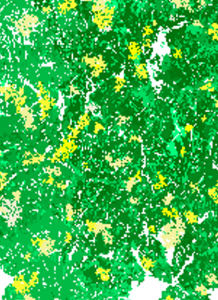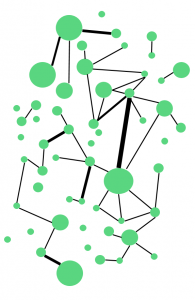Forest management for multiple ecological services
Understanding how forest management activities at different spatial and temporal scales interfere with ecological processes to influence the supply of ecological services is one of the most important challenge of forest management.
We are developing spatially explicit models of forest dynamics that simulates harvesting together with forest growth and natural disturbances. We determine the annual allowable cut by optimizing for multiple services (timber production, carbon sequestration, biodiversity, etc.) and we test how different management strategies affect the trade-offs and benefits between the services. We are asking the following questions: How do natural disturbances impact these trade-offs and benefits? Can a management strategy that optimizes the yield of multiple services act as a protection against the uncertainties associated with natural disturbances and climate change?
Spatial network approaches to biodiversity conservation
Spatial networks are increasingly being used to characterize the structural and functional consequences of landscape fragmentation on biodiversity.
We employ spatial networks in a forest management context to determine how differences in the spatial distributions of logging activities impact habitat connectivity for wildlife species. In particular, we investigate how uneven-aged cuts, a practice usually deemed favorable for forest biodiversity at the stand-scale, may have negative impacts at the landscape-scale.
We also employ spatial networks to extend the concept of functional response diversity from the community- to the metacommunity-level. Functional response diversity has been used as a proxy to quantify ecological resilience, given the ability of multi-trait indices to detect community-level responses to a range of disturbances. We employ spatial network approaches to assess whether tree seed dispersal in fragmented forests can buffer a decrease in functional response diversity caused by fragmentation. We also investigate the relative importance of functional diversity and landscape topology in alleviating the effects of different disturbances on ecosystem functioning.
Metacommunity dynamics of forest insect pests
Populations of insect herbivores generally vary as a function of both the abundance of plant resources and of natural enemies. At the landscape scale, spatial heterogeneity in plant resources and fragmentation may alter the strength of these bottom-up and top-down impacts by supporting different communities of herbivores, parasitoids and hyperparasitoids. We combined food web approaches and spatially explicit metacommunity models to investigate the relationships between landscape heterogeneity and insect pest dynamics in forest ecosystems.


